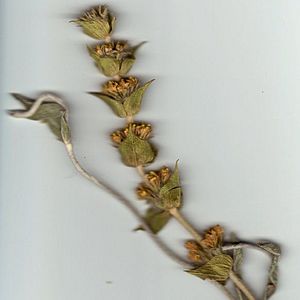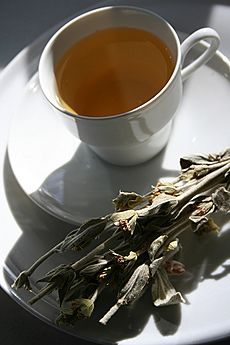Ironwort facts for kids
Quick facts for kids Ironwort |
|
|---|---|
 |
|
| Sideritis syriaca (ironwort) | |
| Scientific classification |
|
| Kingdom: | Plantae |
| Clade: | Tracheophytes |
| Clade: | Angiosperms |
| Clade: | Eudicots |
| Clade: | Asterids |
| Order: | Lamiales |
| Family: | Lamiaceae |
| Subfamily: | Lamioideae |
| Genus: | Sideritis L. |
| Species | |
|
See text |
|
Sideritis, also known as ironwort, mountain tea, or shepherd's tea, is a group of flowering plants. People often use these plants as herbal medicine, especially to make a type of herbal tea. You can find Sideritis plants mostly in the Mediterranean area, like the Balkans and the Iberian Peninsula. They also grow in Central Europe and parts of Asia.
Contents
What's in a Name? The History of Sideritis
The name "sideritis" comes from the Greek word for "he who is made of iron." Ancient Greeks, like Pedanius Dioscorides and Theophrastus, knew about this plant. In ancient times, "sideritis" was a general name for plants that could help heal wounds. People believed these plants were useful for injuries caused by iron weapons during battles. Another idea is that the name comes from the shape of the plant's sepal, which looks a bit like the tip of a spear.
Plant Families: How Sideritis is Classified
Scientists use something called molecular research to understand how plants are related. In 2002, this research showed that Sideritis and five other plant groups are closely related to a plant called Stachys. More studies are needed to fully sort out these plant families.
There are many different kinds of Sideritis plants. Some scientists recognize up to 319 different types, including species, subspecies, and forms. Here are a few examples:
- Sideritis barbellata Mend.-Heu. - Found only on the La Palma island.
- Sideritis candicans Aiton - Grows only on the Madeira, Bugio Island, and Porto Santo Island.
- Sideritis cypria Post - Found only in Cyprus.
- Sideritis euboea Heldr - Grows on the island of Euboea.
- Sideritis hyssopifolia L. - Found in the mountains of the Iberian Peninsula.
- Sideritis lanata L.
- Sideritis leucantha Cav.
- Sideritis macrostachyos Poir.
- Sideritis montana L.
- Sideritis purpurea Talb. - Grows in western Greece, the Ionian Islands, and Crete.
- Sideritis raiseri Boiss & Heldr - Found on Mount Tomorr in Albania.
- Sideritis remota Urv.
- Sideritis romana L.
- Sideritis scardica Gris. - Native to the Sharr Mountains across Kosovo, North Macedonia, and Albania. It also grows in Bulgaria.
- Sideritis syriaca L., S. cretica Boiss, S. boissieri Magn. - Found in Syria, Turkey, and Crete. These are often called Malotira.
- Sideritis theezans Boiss & Heldr - Grows in the Peloponnese region.
It can be tricky for botanists (plant scientists) to name and classify these plants. This is because their differences can be very small.
Plant Features: What Sideritis Looks Like
Sideritis plants are usually small, growing from 8 to 50 centimeters tall. They are xerophytic, meaning they are adapted to dry places. They can be subshrubs (small shrubs) or herbs. Some live for one year, while others live for many years.
These plants often grow at high altitudes, usually above 1000 meters. They can grow with very little soil, sometimes right on rocks. Their stems and leaves are often covered in fine, woolly hairs. This fuzzy coating helps them survive in dry, harsh conditions.
Gallery
Uses: How People Use Sideritis
In countries like Albania, Bulgaria, Greece, North Macedonia, and Turkey, many types of Sideritis are used. People use them as herbs to make teas or to add flavor to food. To make the tea, they boil the stems, leaves, and flowers in water. Often, people add honey and lemon to the tea.
Some Sideritis plants have been used in traditional herbal medicine for a long time. Universities in the Netherlands and the southern Balkans are studying the possible health effects of these plants. Scientists have found special chemicals in Sideritis, such as diterpenoids and flavonoids.
Growing Sideritis: Cultivation
Sideritis raeseri is the most common type of Sideritis grown in Albania, Bulgaria, Greece, and North Macedonia. Farmers often plant it in October-November or February-March. They harvest the plant in July when it is fully blooming. After harvesting, the plant is usually dried before it is used.
See also
 In Spanish: Rabo de gato para niños
In Spanish: Rabo de gato para niños




